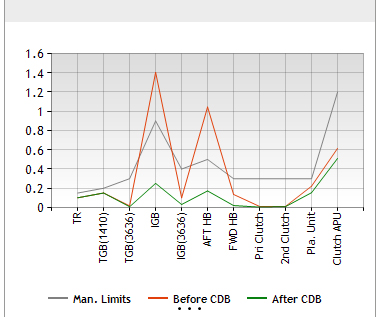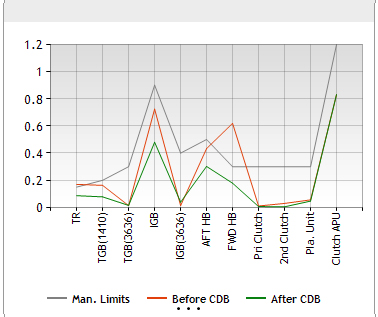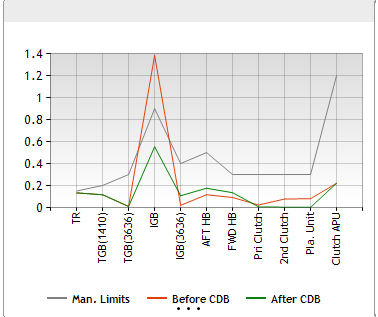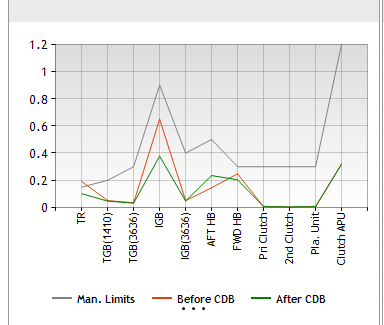Algorithms with Precise Balancing Results
Balancing Results, below are some of the CDB balancing results samples
BAD FORWARD HANGER BEARING
CDB activity was carried out on the AH 64 Apache Helicopter. Initial testing
revealed an imbalance on the tail rotor at a level of 0.236 ips. The tail rotor
vibration levels were reduced to 0.037 by the CDB team. Further analysis of the
data collected during this initial test revealed that a higher level of
vibration had been detected at the forward hanger bearing. Several attempts at
coarse adjustments utilizing the Number 3 and 4 shafts to reduce this condition
had little effect. The CDB computer recommended that forward hanger bearing be
replaced. The bearing was replaced and positively identified by maintenance
staff as unserviceable on removal.
HIGH VIBRATIONS
At the request of the client, The CDB team investigated unresolved vibration
related issues of an Apache aircraft. During the process the team discovered
that the APU was loose on its mounts. The APU condition was assessed and it was
decided to continue with the CDB assessment as the APU is off when any of the
vibration signatures are collected. The aircraft ground runs were carried out
with the cooperation of the maintenance Test Pilot  and quickly revealed high
levels of modulation in the Intermediate Gearbox (IGB) at approximately 103%.
Additionally, the readings at the forward hangar bearing gave a high vibration
level of 0.567 Ips.
and quickly revealed high
levels of modulation in the Intermediate Gearbox (IGB) at approximately 103%.
Additionally, the readings at the forward hangar bearing gave a high vibration
level of 0.567 Ips.
Using CDB technology, a successful series of coarse and fine adjustments were
made to Nos 4 & 5 driveshafts (indexing both shafts and adding 7 grams of
weight tapes to No 5 shaft) which culminated in an overall reduction of
modulation in the IGB to 41% and a reduced vibration level at the forward hangar
bearing of 0.209 Ips.
Following the successful process of adjustments the APU issue was addressed.
HIGH VIBRATIONS
After maintenance phase and tail rotor gear box replacement, CDB activity was
carried out on Apache aircraft  During the data collection process the CDB team
detected a high vibrations in the Intermediary gearbox and AFT hanger bearings.
Re-indexing has been made to drive shaft no 3 due to additional vibrations in
the main transmission gearbox. Modulation (re-indexing and weight changes)
adjustments have been made to Intermediate gearbox. Additionally, driveshaft no
6 have been balanced as well as driveshaft no 5. The CDB team recommended
checking the lateral vibration in main rotor head on the ground.
During the data collection process the CDB team
detected a high vibrations in the Intermediary gearbox and AFT hanger bearings.
Re-indexing has been made to drive shaft no 3 due to additional vibrations in
the main transmission gearbox. Modulation (re-indexing and weight changes)
adjustments have been made to Intermediate gearbox. Additionally, driveshaft no
6 have been balanced as well as driveshaft no 5. The CDB team recommended
checking the lateral vibration in main rotor head on the ground.
HIGH VIBRATIONS
The team of engineers from Shake’d Technologies revealed a slight increase in
vibration from previous CDB activity which  was carried approximately 400 flight
hrs beforehand. Using CDB technology, a successful series of coarse and fine
adjustments were made to No’s 3, 4 & 5 drive shafts (indexing shafts and adding
weight) which contributed to the overall reduction of vibration levels at main
drive train components. Following the successful process of adjustments the CDB
equipment was removed and the aircraft is released for 125 flight hrs before CDB
re-check is required.
was carried approximately 400 flight
hrs beforehand. Using CDB technology, a successful series of coarse and fine
adjustments were made to No’s 3, 4 & 5 drive shafts (indexing shafts and adding
weight) which contributed to the overall reduction of vibration levels at main
drive train components. Following the successful process of adjustments the CDB
equipment was removed and the aircraft is released for 125 flight hrs before CDB
re-check is required.
INOPERATIVE ACCELEROMETER & HIGH VIBRATION
During initial CDB run on Apache aircraft, it was discovered that the tail
rotor gearbox had a resonant vibration of 1.63 IPS. This vibration level should
have illuminated the GBX Vibration message on the UFD. No message was displayed.
After CDB process of troubleshooting, the team found that the accelerometer was
inoperative in not providing a signal to cause the C/W/A message to appear on
the UFD. Additionally, the Intermediary gearbox had a vibration of 1.34 IPS and
modulation of 85%. This data should have caused the GBX Vibration message to be
displayed as well. The Number 7 drive shaft had a vibration of 0.734 IPS at the
accessory gearbox input. CDB vibration limits reveals that any vibration above
0.5 can cause a quick acceleration to an excessive vibration and wear to the  over running clutches in the accessory gearbox. Rotation of the input flange by
the CDB team brought the vibration down to 0.34 IPS. (see graph)
It is important to note that the combination of the TGB and IGB vibrations is an
extremely dangerous combination that creates resonant
frequency vibrations to travel between the gearboxes along drive shaft the # 6
as the frequencies attempt to harmonize. This harmonic resonance is critical and
could result in failure of the drive shaft, TGB, or IGB at some point in the
future of this aircraft.
After balancing the drive train the vibration levels were reduced to 0.88 at TGB
and to 0.553 at IGB as well as reduction to 14% in modulation levels.
over running clutches in the accessory gearbox. Rotation of the input flange by
the CDB team brought the vibration down to 0.34 IPS. (see graph)
It is important to note that the combination of the TGB and IGB vibrations is an
extremely dangerous combination that creates resonant
frequency vibrations to travel between the gearboxes along drive shaft the # 6
as the frequencies attempt to harmonize. This harmonic resonance is critical and
could result in failure of the drive shaft, TGB, or IGB at some point in the
future of this aircraft.
After balancing the drive train the vibration levels were reduced to 0.88 at TGB
and to 0.553 at IGB as well as reduction to 14% in modulation levels.
HIGH VIBRATIONS AT FWD/AFT HANGER BEARINGS
CDB activity was carried out on the AH 64 Apache Helicopter. During the process
a higher than normal vibration levels were detected at the forward and aft
hangar bearings along with the input drive of the intermediate gearbox. It was
also found that the  tail rotor was out of balance.
tail rotor was out of balance.
In order to compensate for the vibration levels detected at the forward hangar
bearing, fine tuning weights were applied to the No 3 driveshaft. To compensate
for the levels of vibration detected at the aft hangar bearing and the
intermediate gearbox input drive, fine-tuning weight tapes were applied to the
No 5 driveshaft. The tail rotor was quickly rebalanced the team. The levels of
vibration-recorded post the application of fine-tuning weights and the tail
rotor rebalance were significantly reduced. A recommendation was made by the CDB
team to check the onboard vibration monitoring system for serviceability.
HIGH VIBRATIONS AT AFT HANGER BEARING
CDB activity was carried out on the AH-64 Apache Helicopter. It was quickly
established during the process that higher than normal vibration levels were
detected at the aft hangar bearing along with the input drive of the
intermediate gearbox.  In order to compensate for the vibration levels detected
at the aft hangar bearing and the intermediate gearbox input, drive fine tuning
weights were applied to the No 5 driveshaft. Additionally, a calculated coarse
adjustment (Rotation of the shaft) and weight tape were added to the No 4
driveshaft. This action reduced the vibration levels significantly at the aft
hangar bearing.
In order to compensate for the vibration levels detected
at the aft hangar bearing and the intermediate gearbox input, drive fine tuning
weights were applied to the No 5 driveshaft. Additionally, a calculated coarse
adjustment (Rotation of the shaft) and weight tape were added to the No 4
driveshaft. This action reduced the vibration levels significantly at the aft
hangar bearing.
The CDB team recommended that the aft hangar bearing be replaced due to the
vibration levels that have been applied to this component. A further
recommendation was made that onboard vibration monitoring system be checked for
serviceability.
RESULTS




